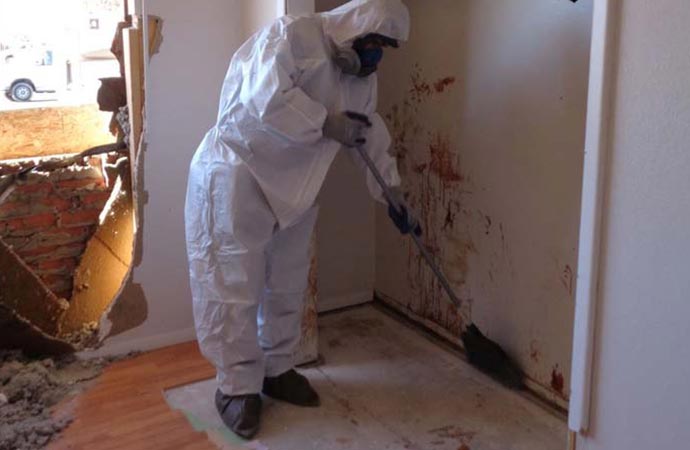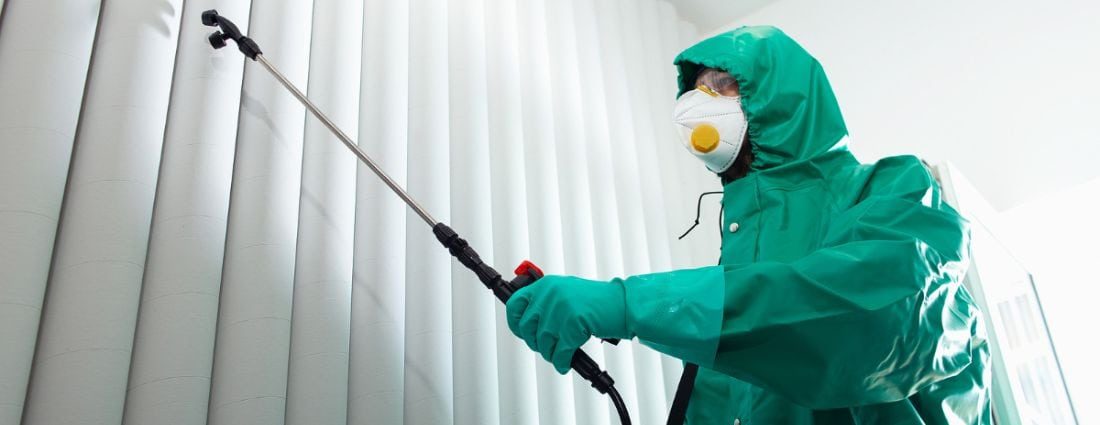Decomposition Death Clean Up: Specialized and Respectful Remediation
Decomposition Death Clean Up: Specialized and Respectful Remediation
Blog Article
Expert Biohazard Cleansing and Purification for Blood, Bodily Fluids, and Hazardous Products
The possible wellness risks associated with direct exposure to biohazards highlight the critical need for precise handling and extensive cleaning. As we browse the detailed landscape of biohazard cleanup, understanding the nuances of laws, conformity, and the customized equipment at play ends up being necessary in making certain a safe and comprehensive decontamination procedure.
Health Threats of Biohazard Direct Exposure
Direct exposure to biohazards postures substantial wellness dangers that can lead to extreme repercussions for people and neighborhoods alike. Biohazards include a wide variety of biological compounds, consisting of blood, physical liquids, mold and mildew, microorganisms, viruses, and other potentially infectious materials. When people enter contact with these biohazards, whether with crashes, incorrect handling, or environmental direct exposure, they face the risk of contracting serious health problems or conditions.
Among the key health and wellness dangers connected with biohazard exposure is the transmission of transmittable conditions. Bloodborne microorganisms such as HIV, liver disease B and C, and numerous bacteria can be present in biohazardous materials, posing a straight threat to human health and wellness. Inhaling airborne biohazards like mold spores or entering call with infected surface areas can additionally result in breathing issues, allergies, and other negative health results.
In addition, biohazard exposure can have long-term wellness ramifications, with some conditions showing up years after the initial contact (Blood Cleanup). As a result, it is important to prioritize correct biohazard cleansing and decontamination to reduce these health risks and ensure the safety of individuals and neighborhoods

Specialized Training for Biohazard Cleaning
When it concerns handling biohazard cleanup efficiently and safely, specialized training plays a basic role in ensuring correct decontamination procedures are adhered to. Biohazard clean-up calls for specific understanding and skills to effectively mitigate dangers related to bloodborne pathogens, physical fluids, and unsafe materials. Specialists learnt biohazard clean-up undertake extensive instruction on exactly how to securely manage, remove, and dispose of biohazardous materials to protect against contamination and exposure.
Specialized training for biohazard clean-up covers a series of crucial topics, consisting of appropriate individual safety tools (PPE) use, bloodborne pathogen awareness, purification techniques, and hazardous waste disposal procedures. Individuals learnt biohazard cleanup are equipped with the essential expertise to assess contamination levels, identify prospective dangers, and carry out ideal cleaning treatments in conformity with governing criteria.
Constant training and education and learning are extremely important in the area of biohazard cleaning to remain upgraded on the latest decontamination technologies, safety methods, and regulations. By spending in specialized training, biohazard cleaning professionals can successfully react to emergency situation cleaning circumstances and secure both public health and wellness and the atmosphere.
Relevance of Appropriate Decontamination Strategies
Using correct decontamination techniques is essential in biohazard cleanup to effectively remove unsafe products and lessen wellness risks. Reliable purification not only ensures the elimination of noticeable traces of blood, bodily fluids, and other biohazards however additionally targets undetectable pathogens that may present major health hazards otherwise correctly eradicated. By adhering to stringent decontamination methods, trained professionals can significantly decrease the risk of direct exposure to harmful microbes, viruses, and bacteria that might result in illness or infections.
Proper decontamination strategies involve making use of customized devices and anti-bacterials that are particularly made to reduce the effects of biohazards successfully. Extensive cleansing and disinfection of polluted areas are necessary to prevent the spread of virus and ensure a safe environment for owners. In addition, the correct disposal of biohazardous waste adhering to decontamination procedures is crucial in stopping contamination of other surfaces or individuals.

Equipment and Devices for Safe Cleaning
The appropriate devices and tools play a crucial duty in guaranteeing the risk-free and efficient cleanup of biohazardous products. When taking care of blood, physical liquids, or unsafe products, biohazard cleaning experts count on specialized equipment to minimize direct exposure threats and extensively sanitize the affected location. Individual protective equipment (PPE) such as gloves, coveralls, masks, and goggles are vital to protect versus straight call with potentially contagious products. In addition, biohazard cleaning kits containing anti-bacterials, absorbing products, and biohazard bags are utilized to safely dispose and include of contaminated items. Blood Cleanup.
Advanced cleansing tools like hospital-grade disinfectants, HEPA-filtered vacuums, and misting equipments are used to disinfect surfaces and remove crime scene cleaner game biohazards successfully. Specialized equipment such as sharps containers and biohazard garbage disposal bins are made crime scene cleanup youtube use of to safely handle sharp things and biohazardous waste products. By using the best tools and devices, biohazard cleaning professionals can ensure a detailed clean-up procedure that prioritizes safety and security and reduces wellness threats for both employees and occupants of the affected area.
Rules and Compliance in Biohazard Cleaning
Appropriate adherence to guidelines and conformity criteria is critical in biohazard cleansing to make certain the safety of both workers and the environment. Government agencies such as OSHA (Occupational Safety and Health And Wellness Management) and the EPA (Environmental Defense Company) have established details guidelines for biohazard cleaning procedures to reduce health risks and ecological contamination. These guidelines cover a variety of aspects including the handling, transport, and disposal of biohazardous materials, in addition to the essential training and protective tools needed for workers associated with the cleanup process.
Biohazard cleansing business have to remain updated with these laws to ensure that their operations satisfy the called for safety criteria. Failing to abide by these regulations can cause severe repercussions, consisting of fines, lawful activity, and endangering the health and wellness of people and the environment. By following strict guidelines and compliance actions, biohazard cleaning companies can efficiently mitigate threats and make certain a risk-free and extensive clean-up procedure for all parties entailed.
Conclusion
To conclude, biohazard cleaning and purification call for customized training, proper strategies, and adherence to policies. Direct exposure to blood, bodily liquids, and dangerous materials presents significant health threats, making it critical to utilize the right equipment and devices for safe clean-up. By adhering to rigorous procedures and guidelines, experts can properly alleviate the threats related to biohazard direct exposure and ensure the safety and security of both themselves and others.
As we browse the detailed landscape of biohazard cleanup, comprehending the nuances of guidelines, conformity, and the customized equipment at play comes to be important in ensuring a secure and extensive purification process. (Blood Cleanup)
When see here now it comes to handling biohazard cleaning successfully and securely, specialized training plays a fundamental function in making sure correct purification procedures are followed.Utilizing proper decontamination strategies is critical in biohazard clean-up to successfully eliminate harmful materials and decrease health threats. In addition, biohazard cleansing sets including disinfectants, absorbing products, and biohazard bags are used to safely get rid of and include of infected things.
Government agencies such as OSHA (Occupational Safety And Security and Health And Wellness Administration) and the EPA (Environmental Protection Agency) have developed details guidelines for biohazard cleanup procedures to minimize health threats and ecological contamination.
Report this page